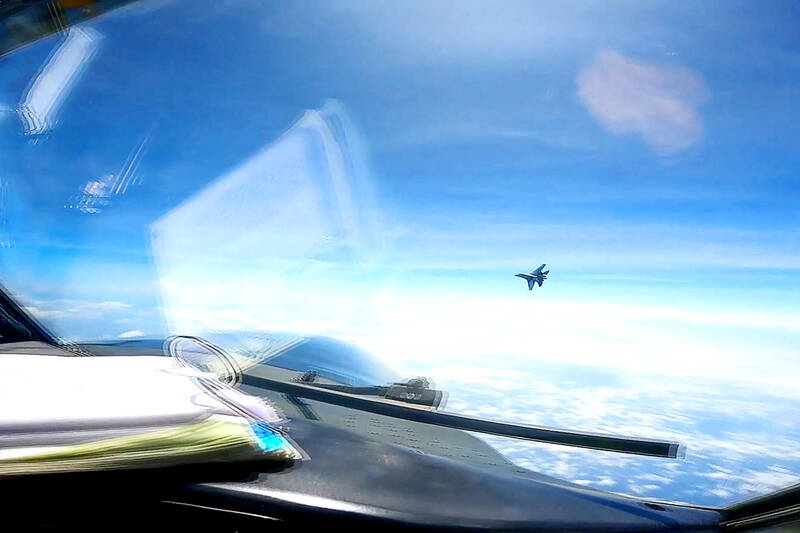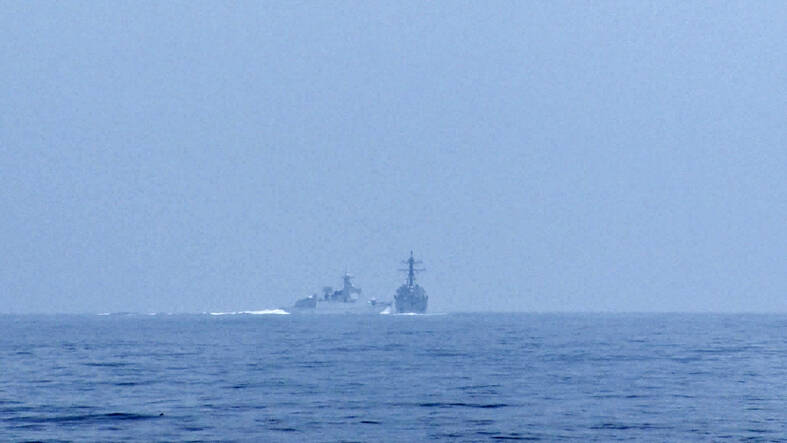When a Chinese warship came within 136 meters of a US destroyer in the Taiwan Strait on Saturday and forced it to slow down, it was the second time in as many days that Chinese and US Military personnel came close to a major incident.
Late last month, a Chinese fighter jet flew in front of an American warplane over the South China Sea, drawing a reprimand from the US.
After the warship encounter on Saturday, the White House accused China of “increasing aggression.” China has said that such US military activity in international waters is “deliberately creating risks.”

Photo: AFP
CHINA PUSHING BACK
Under President Xi Jinping (習近平), China has begun carrying out what US officials say is one of the largest peacetime military buildups in history.
Beijing is using its growing military might and economic clout to push back decades-old US military dominance in Asia. China views the US as an outsider interfering in a region in which it sees itself as a force for peace and stability.

Photo: Reuters
A particular source of tension are “freedom of navigation” patrols in which the US and its allies escort naval vessels through the Taiwan Strait and the South China Sea.
The US maintains that such patrols protect the right of all nations to sail in international waters.
China has complained about US ships and aircraft close to islands it controls, claims or has built and turned into military installations in the Taiwan Strait and in the South China Sea. The People’s Liberation Army Navy (PLAN) usually pursues American ships.
Some analysts say this has encouraged Chinese military commanders to act more assertively against foreign military ships and aircraft.
Defense expert Jennifer Parker said, “I think what we’re seeing is a general incentive, perhaps even an incentive scheme, for (PLA) unit commanders to go on the offensive when the opportunity arises, which is at the unit level,” but encourages more reckless behavior.”
Other recent incidents in the South China Sea have seen a Chinese coast guard ship directing a “military-grade laser” at a Philippine vessel in February, and Vietnam last month demanding Beijing remove survey vessels from its waters.
China said both incidents were legitimate and normal.
Its defense ministry did not immediately comment on claims that it was encouraging more aggressive behavior.
This PLA approach increases the likelihood of a confrontation that could turn into an armed conflict, says Derek Grossman, senior defense analyst at the US think tank RAND Corporation.
“In my view, this is the No. 1 scenario that leads the US and China to war, and it has less of Beijing seizing a facility in the disputed South China Sea or invading Taiwan,” he said.
COLLISION COURSE
To make matters worse, the US and China have different views on the source of the problem. The US sees China as disrupting the status quo with its threats against Taiwan, the self-governing island that China claims as its own, and its territorial claims over the resource-rich South China Sea.
The answer from the US perspective is to continue to assert its right of sailing and flying over China.
Tong Zhao, a visiting scholar at Princeton University’s School of Public and International Affairs, said China’s ruling Communist Party views the US actions as a provocation and believes that US efforts for military dominance are the real cause of threats in the region.
“Chinese officials generally do not see China’s own behavior as contributing to the risk,” he said. “And so their argument is that China can only reduce the risk by increasing its military measures to counter America’s aggressive behaviors and to make the United States feel genuinely concerned about events. And only then the United The United States will ultimately take the necessary measures to reduce the risk.”
NO COMMUNICATION
Add to this another problem: the lack of reliable means of communication between the two armies.
The US military has long been pushing China for open lines of communication with the PLA — at both senior and lower levels — to reduce the risk that accidents could lead to military flare-ups.
In contrast, US officials say, China’s leaders have been slow to establish military contacts and quickly shut them down during periods of diplomatic tension.
China suspended several high-level military talks with the Pentagon after former US House Speaker Nancy Pelosi visited Taiwan last summer and the defense chiefs of the two countries shot down a Chinese spy balloon over US airspace.
A senior US defense official told Reuters on condition of anonymity that China has declined or not responded to more than a dozen requests to speak with the Pentagon and about ten working-level engagement requests since 2021. .
China’s Defense Ministry did not immediately respond to requests for comment.
Analysts say China is wary of military talks that could give the US more insight into the PLA’s operations. Chinese leaders would also like to keep US-China discussions focused on trade and economic issues.
However the threats are not imaginary.
An American spy plane made an emergency landing on Hainan Island in 2001 after a collision with a Chinese fighter jet.
A Chinese pilot died and Beijing detained the 24-man American crew for 11 days, releasing them only after Washington sent a letter saying it was “very sorry.”

Nov. 11 to Nov. 17 People may call Taipei a “living hell for pedestrians,” but back in the 1960s and 1970s, citizens were even discouraged from crossing major roads on foot. And there weren’t crosswalks or pedestrian signals at busy intersections. A 1978 editorial in the China Times (中國時報) reflected the government’s car-centric attitude: “Pedestrians too often risk their lives to compete with vehicles over road use instead of using an overpass. If they get hit by a car, who can they blame?” Taipei’s car traffic was growing exponentially during the 1960s, and along with it the frequency of accidents. The policy

While Americans face the upcoming second Donald Trump presidency with bright optimism/existential dread in Taiwan there are also varying opinions on what the impact will be here. Regardless of what one thinks of Trump personally and his first administration, US-Taiwan relations blossomed. Relative to the previous Obama administration, arms sales rocketed from US$14 billion during Obama’s eight years to US$18 billion in four years under Trump. High-profile visits by administration officials, bipartisan Congressional delegations, more and higher-level government-to-government direct contacts were all increased under Trump, setting the stage and example for the Biden administration to follow. However, Trump administration secretary

In mid-1949 George Kennan, the famed geopolitical thinker and analyst, wrote a memorandum on US policy towards Taiwan and Penghu, then known as, respectively, Formosa and the Pescadores. In it he argued that Formosa and Pescadores would be lost to the Chine communists in a few years, or even months, because of the deteriorating situation on the islands, defeating the US goal of keeping them out of Communist Chinese hands. Kennan contended that “the only reasonably sure chance of denying Formosa and the Pescadores to the Communists” would be to remove the current Chinese administration, establish a neutral administration and

A “meta” detective series in which a struggling Asian waiter becomes the unlikely hero of a police procedural-style criminal conspiracy, Interior Chinatown satirizes Hollywood’s stereotypical treatment of minorities — while also nodding to the progress the industry has belatedly made. The new show, out on Disney-owned Hulu next Tuesday, is based on the critically adored novel by US author Charles Yu (游朝凱), who is of Taiwanese descent. Yu’s 2020 bestseller delivered a humorous takedown of racism in US society through the adventures of Willis Wu, a Hollywood extra reduced to playing roles like “Background Oriental Male” but who dreams of one day